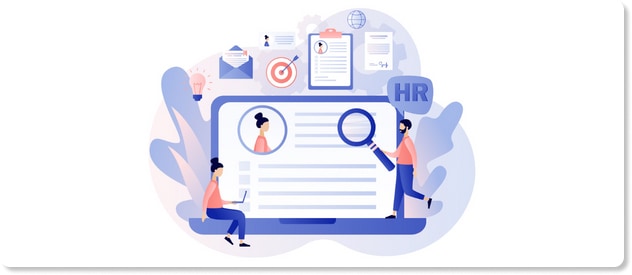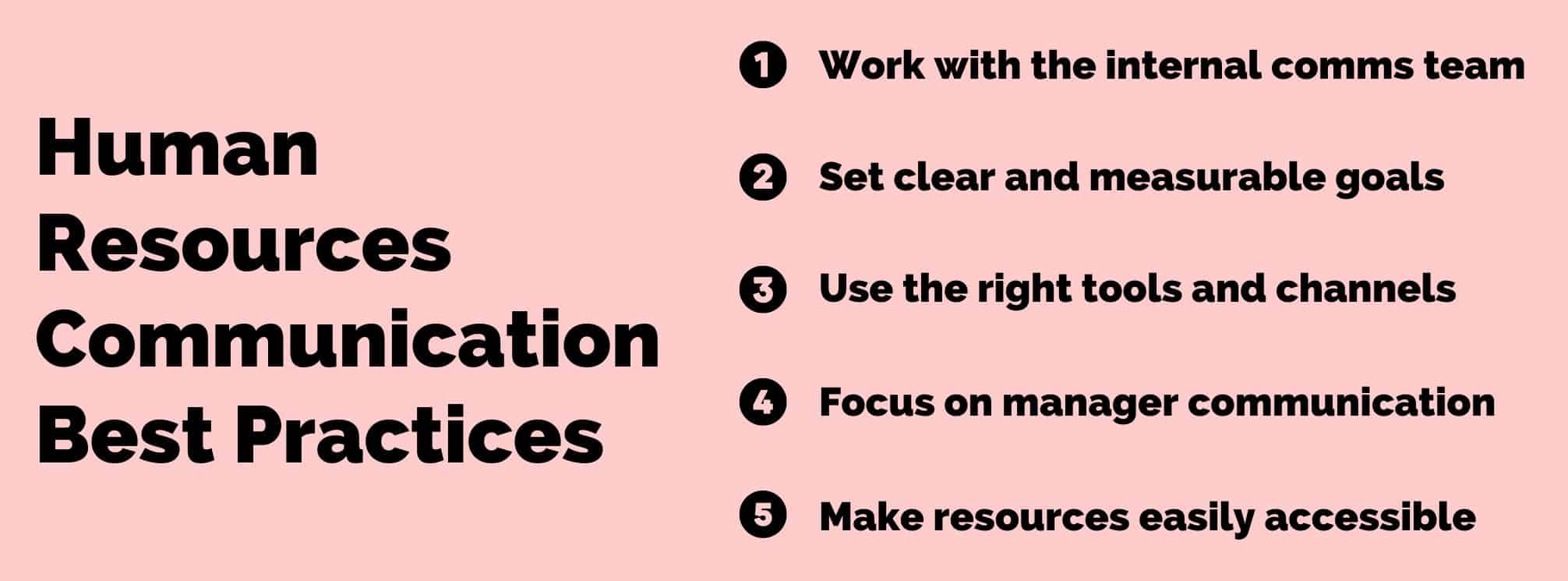What is HR Communication?
HR Communication is a large category of internal communication between a company and its employees. Human resources communication covers all the different types of HR: recruitment, labor relations, training and development, and human resources information systems (HRIS).
What is Human Resources Communication?
The types of messages that are considered HR communications are vast. This includes:
- Daily operations (e.g. policies and procedures): day-to-day updates and changes regarding anything related to human resources and employee experience
- Compliance communication: messages to remind employees about trainings, policies, and expectations
- Training and development: compliance messages to ensure employees are following laws and company policies as well as opportunities for development within the company (e.g. leadership training)
- Benefits and open enrollment communication: information about what employee benefits a company offers, how to enroll in them, and any plan changes
- Hiring and recruitment: information about open positions and communication campaigns to attract candidates
- Employee onboarding: welcoming new employees and getting them quickly up to speed and in compliance
- Employee exits: interviews and data gathering when employees leave the company
- HRIS information: messages about the company’s HRIS (e.g. ADP, Workday)
But many HR professionals, similar to internal communications professionals, can also be responsible for culture building initiatives. So, HR comms might also include information about:
- Diversity, equity, and inclusion (DEI): messages about a company’s progress with improving DEI. This is helpful for retention and hiring efforts as well as helping the company’s ability to innovate and continue being successful.
- Workplace belonging: belonging is another facet of diversity, equity, and inclusion. These messages are important for creating a healthy workplace culture and environment where workers are set up for success.
- Leadership development: developing managers and leaders within a company is key to employee engagement, retention, and worker productivity.
- Team building events (e.g. offsites & holiday parties): in an increasingly remote and disparate workforce, team building events are an important way to keep people engaged and connected.
- Employee recognition programs: recognition is an important part of a retention strategy for workers that simultaneously improves productivity, performance, and the overall employee experience.
[optin-monster slug=”fovojf3wjxehslxkho4j” followrules=”true”]
HR Communication Goals
All successful communication campaigns are rooted in clear objectives. For HR, the goals of behind what they communicate may include:
- Improving employee awareness and knowledge of rules and the resources available to them.
- Reducing voluntary turnover.
- Increasing employee engagement scores and employee net promoter scores (eNPS).
- Decreasing the incidence of disciplinary actions.
- Improving participation in open enrollment and benefits.
- Hiring the right people and creating efficiencies in the hiring process.
There are many other goals that might be behind the communication of HR initiatives, but typically HR is held accountable for hiring, turnover, compliance, and improving employee experience (EX). If there is a separate internal communication function within a business, HR often will partner with them to achieve these goals via a strong internal communication strategy.
HR Comms Best Practices
If you want to improve HR communication, start with these best practices.
Create an internal communications strategy and work with the internal comms team.
If your company has an in-house internal comms function, definitely partner with them for the best success. But even if your company doesn’t have a dedicated internal communications team, HR can still create an internal comms strategy. A few pillars for a great IC strategy are to:
- Conduct an internal comms audit annually
- Host a regular stakeholder meeting to align departments
- Plan communication far enough in advance
Set clear & measurable goals.
It’s hard to communicate well if you don’t have an end-goal in mind. Communicating just to raise “awareness” is not only difficult to measure, but also sells your important human resources initiatives and programs short. So, set clear goals (like SMART goals) and then measure your success in real-time with pulse surveys and focus groups.
Use the right communication tools/channels for each audience segment.
Getting your channel mix right is so important to successful HR communication.
You want to first choose the right medium for your message. For example, it might be best to do an explainer video for benefits enrollment, rather than having everything written out. This is because benefits are a complex subject that many employees don’t fully understand.
You then want to select the right channel(s) for the message. For example, just sending the benefits video via email might miss your deskless workers without an email address.
Focus on manager communication to support HR top-down messaging.
Managers are key to the success of any internal communications campaign. Give managers specific talking points and expectations so they can properly support the message from corporate HR.
Make resources easily accessible.
HR is an important topic, but it can be difficult for employees to find the resources that matter. Where does the employee handbook live? How do they log in to their HRIS? Where can they read HR updates? And do all these resources live in different places? Creating resource hubs on various channels is a great way to make messages more accessible.
What Are Challenges to Effective HR Communication?
There are several main challenges that make it difficult to clearly communicate human resources information to employees.
- Lack of access. Most modern employee communication tools are not mobile-first and are not accessible to deskless workers. Because of this, a large percentage of employees do not receive equal access to important HR information.
- Lack of understanding. HR messages can be complex. Whether it’s a new policy or employee benefits, these messages can often be misunderstood by employees. This problem is made even worse when companies default to corporate jargon and do not write for their audience.
- Lack of interest. Despite how HR might feel about their communications, many HR messages are boring. Employees just aren’t interested in policies and procedures, especially when they interrupt the status quo and the WIIFM (what’s in it for me?) isn’t communicated.
- Lack of trust. Unfortunately, HR has earned a reputation over the years of being the workplace police. Rather than being perceived as a resource by employees, HR is often seen as the equivalent of the school principal. This can skew employee feelings towards messages from HR as being inherently negative even when that isn’t the case. And it can dissuade them from asking questions to improve understanding of important information.
HR Comms Technology
HR CommsTech is a growing field. More attention is being paid to employee communication and human resources technology and management. This is largely because of the digital transformation and companies recognizing the importance of employee engagement and workplace culture as key drivers of retention and worker productivity.
There are a few main categories in the HR tech stack:
- Talent Management
- Human Resources Information System (HRIS)
- Learning Management System (LMS) for training
But there is an emerging type of technology specifically for HR communication. Some of the existing types of technology are expanding their functionality to include some lite communication features. But there are also tools like theEMPLOYEEapp, which are made to improve top-down communication across the company, including human resources.
[optin-monster slug=”xbb0pok4ads9enzzcoyy” followrules=”true”]
HR Metrics & Measuring Success
Measuring success with HR metrics and HR analytics are key to great communication.
To measure success, there are a few tools that human resources professionals can use to collect the right data.
Surveys:
- Employee Engagement Surveys: surveys used to understand the employee perspective on a variety of issues (e.g. workplace culture, engagement, eNPS, etc.).
- Pulse Surveys: quick surveys, less than 5 questions, to gauge employee sentiment over time.
- Communication Preferences Surveys: surveys to understand specifically what channels, topics, and means of communication employees prefer.
Qualitative Feedback:
- Focus Groups: meetings with employees to dive deeper into a specific topic of importance to gain first-hand knowledge and experiences.
- Employee Interviews: One-on-one interviews with employees to learn more specific details about various issues, similar to a focus group.
- Empathy Maps: A tool to help understand how big changes (e.g. Mergers and Acquisitions) will impact various groups so you can prepare a communications plan.
- Personas: A tool to define your core employee audiences to understand their needs, preferences, and challenges so you can target and personalize your HR communication strategy to each group.
Channel Data:
- Open Rates: How many people open your message out of the total who received it.
- Adoption Rates: How many people have signed up to use a channel out of the total who could have access.
- Time spent on messages: A calculation of how long users spend on a certain post.
- Push notification open rates: How many people open content from a push notification they receive.
No matter what, HR teams need to take their qualitative and quantitative data and analyze the results. Just because the messages in a campaign had high open rates on your employee app does not mean the campaign was successful. You need to tie your campaigns back to ROI and business objectives.
How theEMPLOYEEapp Helps With HR Communication
theEMPLOYEEapp is an employee communication app and mobile intranet made with frontline workers in mind. With our mobile-first communications app and employee intranet solution, theEMPLOYEEapp provides a solution to reach a dispersed workforce, including office-based and remote employees.
The employee app helps with human resources communication in a number of ways:
- By being mobile-first we help get need-to-know information such as workplace policies and training into the hands of deskless workers who are typically difficult to reach.
- Read Receipts allow your HR team to track if employees acknowledge they have received certain messages, which is valuable for compliance related communications.
- Push Notifications help you designate which messages are time-sensitive and important, cutting back on communication overload and HR updates getting missed.
- Employee engagement functionality helps you build culture and engagement with messages, especially employee recognition, work wins, and other successes.
[optin-monster slug=”ucyxtz2fxemh6aryl4gg” followrules=”true”]





